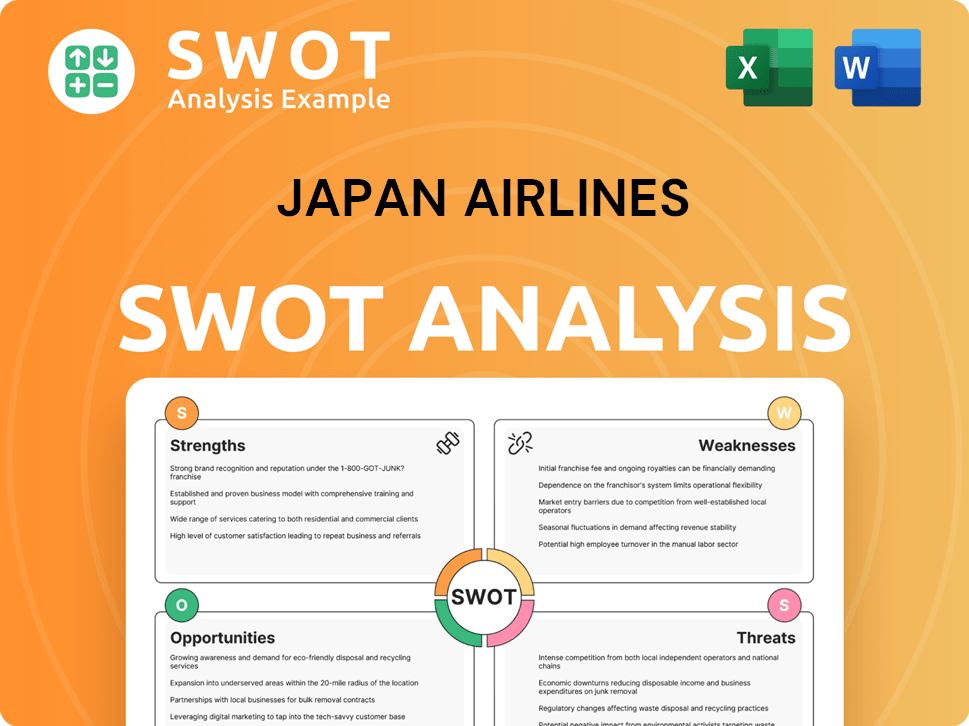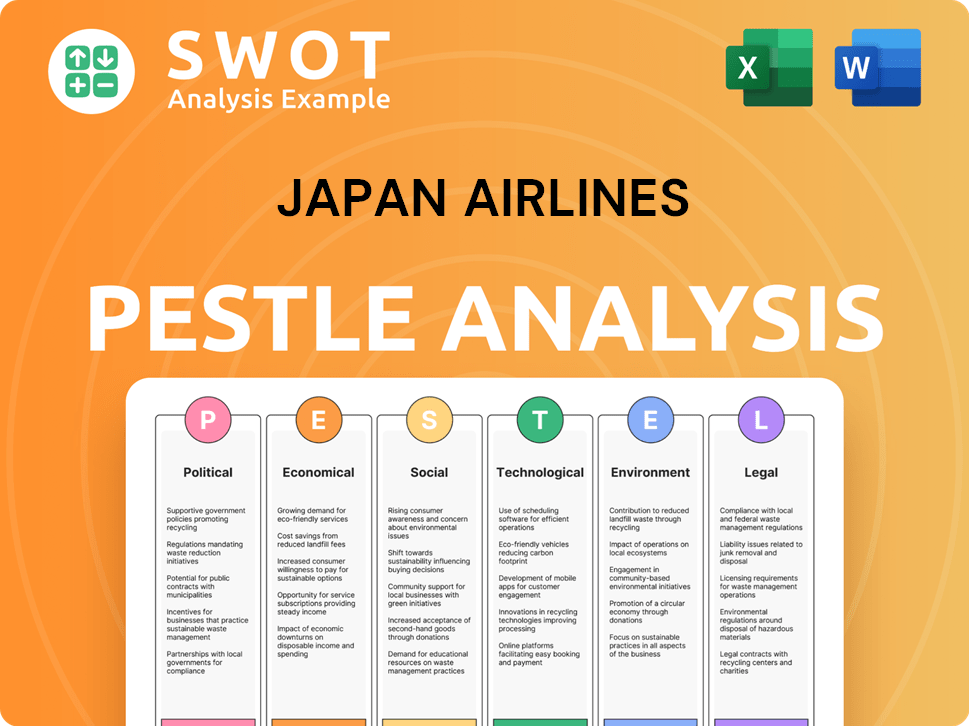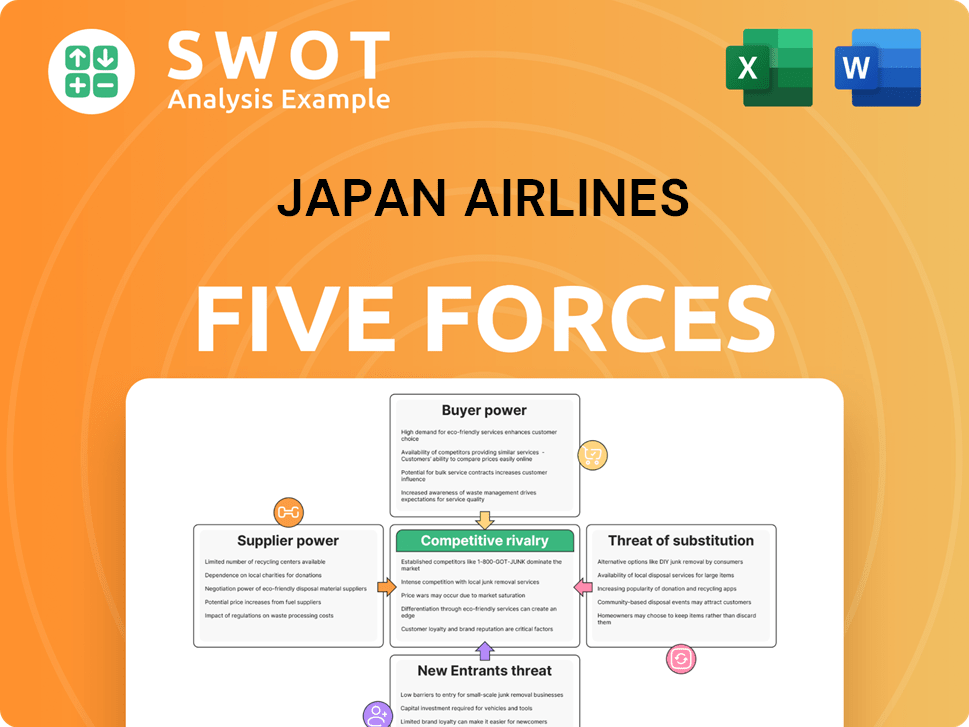Japan Airlines Bundle
How Does Japan Airlines Soar Above the Competition?
In the ever-changing landscape of global aviation, understanding Japan Airlines' (JAL) sales and marketing strategy is crucial for anyone seeking insights into market leadership. JAL's recent moves, including digital transformation and sustainable travel initiatives, showcase its adaptability and forward-thinking approach. This strategic shift has significantly reshaped its market presence, making it a compelling case study for businesses worldwide.

Founded in 1951, Japan Airlines has evolved from a post-war necessity to a global powerhouse, constantly refining its Japan Airlines SWOT Analysis to stay ahead. This document will explore how JAL effectively implements its JAL sales and marketing strategies, focusing on its brand positioning and impactful marketing campaigns. We'll delve into JAL market analysis, examining its target market and how it navigates the competitive Japanese aviation industry, including its digital marketing strategy examples and customer relationship management (CRM) practices. Ultimately, this analysis aims to provide actionable insights into JAL's approach to sales performance, brand loyalty, and revenue management.
How Does Japan Airlines Reach Its Customers?
The sales and marketing strategy of Japan Airlines (JAL) employs a multifaceted approach, leveraging both online and offline channels to maximize its market reach. This strategy is designed to cater to a diverse customer base, from individual travelers to corporate clients, ensuring accessibility and convenience in booking and travel management. The company's focus on digital transformation and strategic partnerships underscores its commitment to adapting to the evolving demands of the aviation industry.
JAL's sales channels are integral to its overall business performance, contributing significantly to its revenue streams and brand presence. The airline's ability to effectively manage and integrate these channels is crucial for maintaining its competitive edge in the global aviation market. The following sections delve into the specifics of JAL's sales channels, providing insights into their structure, operation, and strategic importance.
The company's approach involves a balanced mix of direct and indirect sales methods, allowing it to serve a broad spectrum of customer needs and preferences. This integrated strategy is key to JAL's success in a competitive market. By optimizing its sales channels, JAL aims to enhance customer satisfaction and drive sustainable growth.
JAL's online sales channels are primarily centered around its official website and partnerships with online travel agencies (OTAs). The official website serves as a central hub for flight bookings, package tours, and ancillary services. Continuous enhancements to the website's user experience and mobile accessibility reflect a strategic shift towards digital adoption.
Offline sales channels remain crucial, particularly for group bookings, corporate clients, and customers who prefer in-person interactions. This includes direct sales teams engaging with corporate accounts and travel agencies globally. JAL maintains strong relationships with wholesale distributors and travel agencies, which act as key intermediaries in various markets.
Key partnerships, such as its membership in the Oneworld alliance, further expand its global reach and market share. This allows code-sharing and reciprocal loyalty program benefits with partner airlines. These alliances effectively extend JAL's network to over 1,000 destinations worldwide, enhancing its competitive advantage in Asia.
The evolution of these channels has seen a strategic shift towards omnichannel integration, aiming to provide a seamless customer experience across all touchpoints. This means customers can start their journey online and complete it through a travel agent, or vice-versa. This approach enhances customer satisfaction and streamlines the booking process.
JAL's sales strategy is characterized by a blend of digital innovation and traditional methods, ensuring a comprehensive approach to customer acquisition and retention. The airline's focus on enhancing its online presence and strengthening relationships with travel partners is critical for its continued success. For more insights, consider reading this article on Japan Airlines sales strategy.
- Enhancing the official website for improved user experience and mobile accessibility.
- Strengthening partnerships with OTAs to boost international sales.
- Maintaining robust relationships with travel agencies and corporate clients.
- Leveraging the Oneworld alliance for expanded global reach and code-sharing.
Japan Airlines SWOT Analysis
- Complete SWOT Breakdown
- Fully Customizable
- Editable in Excel & Word
- Professional Formatting
- Investor-Ready Format

What Marketing Tactics Does Japan Airlines Use?
The marketing tactics employed by Japan Airlines (JAL) are multifaceted, designed to boost brand recognition, generate leads, and boost sales. This strategy integrates both digital and traditional marketing channels to reach a broad audience. The approach is data-driven, with a focus on personalization and customer relationship management to enhance the overall travel experience.
JAL's sales and marketing strategy is continuously evolving, adapting to changing consumer behaviors and technological advancements. The company leverages digital platforms for targeted advertising and content marketing, while also maintaining a strong presence in traditional media. This balanced approach allows JAL to effectively communicate with its diverse customer base and maintain a competitive edge in the aviation industry.
A key element of JAL's strategy involves understanding its target market, which includes both domestic and international travelers. This understanding informs the development of tailored marketing campaigns and promotional offers. For a deeper dive into this, consider exploring the Target Market of Japan Airlines.
JAL uses content marketing on its website and social media to inspire travel and provide information. SEO is crucial for organic traffic, ensuring high visibility in flight searches. Paid advertising targets specific demographics and routes.
Platforms like Instagram, X (formerly Twitter), and Facebook are actively used for customer engagement and promotional campaigns. These platforms are key for brand storytelling and direct interaction with potential customers.
Email marketing is utilized for customer relationship management (CRM), sending personalized offers and flight updates. This helps maintain customer loyalty and provides tailored travel solutions.
JAL collaborates with travel bloggers and content creators to reach niche audiences and build credibility. This expands reach and enhances brand perception among specific demographics.
TV, radio, and print media are used for broad brand awareness campaigns, particularly in the domestic market. This helps maintain a strong brand presence and reach a wider audience.
JAL uses customer segmentation based on travel history and preferences to deliver personalized marketing messages. Analytics tools track campaign performance and optimize ad spend.
JAL's marketing tactics are designed to enhance customer engagement and drive sales. The focus is on a blend of digital and traditional methods, with an emphasis on personalization and data analysis. This approach allows JAL to maintain a competitive edge in the aviation industry.
- Digital Marketing: Employs SEO, paid advertising, content marketing, and social media engagement to reach a broad audience.
- Traditional Media: Utilizes TV, radio, and print for brand awareness, especially in the domestic market.
- Customer Relationship Management (CRM): Leverages email marketing for personalized offers and flight updates.
- Data Analytics: Uses customer segmentation and analytics tools to optimize campaigns and understand customer behavior.
- Partnerships: Collaborates with travel influencers and participates in industry events to expand reach.
Japan Airlines PESTLE Analysis
- Covers All 6 PESTLE Categories
- No Research Needed – Save Hours of Work
- Built by Experts, Trusted by Consultants
- Instant Download, Ready to Use
- 100% Editable, Fully Customizable

How Is Japan Airlines Positioned in the Market?
Japan Airlines (JAL) strategically positions itself as a premium international carrier, emphasizing Japanese hospitality, reliability, and meticulous attention to detail. Its brand message centers around providing a safe, comfortable, and uniquely Japanese travel experience. The iconic Tsurumaru (crane) logo visually represents tradition, grace, and trust, while communications employ a polite, professional, and reassuring tone, reflecting the Japanese 'omotenashi' philosophy.
JAL differentiates itself through exceptional in-flight service, punctuality, and high-quality cabin products, appealing to discerning travelers. The company focuses on delivering value through superior service rather than solely on price, positioning itself at the higher end of the market. Brand perception data consistently highlights JAL's strong safety record and high customer satisfaction scores, particularly regarding cabin crew service and punctuality.
JAL's brand positioning strategy is crucial for its success in the competitive Japanese aviation industry. The airline's commitment to maintaining brand consistency across all channels, from its website and mobile app to airport lounges and in-flight services, ensures a cohesive brand experience. Furthermore, JAL actively responds to shifts in consumer sentiment, such as the growing demand for sustainable travel, by investing in fuel-efficient aircraft and promoting eco-friendly initiatives, further enhancing its brand appeal.
JAL primarily targets business travelers and leisure tourists who value quality service and a premium experience. This focus allows JAL to cater to a specific segment willing to pay a premium for a superior travel experience.
Key brand attributes include safety, comfort, reliability, and Japanese hospitality. These attributes are consistently communicated across all touchpoints, reinforcing JAL's commitment to providing a premium travel experience.
JAL differentiates itself through superior in-flight service, punctuality, and the quality of its cabin products. These elements contribute to a seamless and comfortable journey, setting JAL apart from competitors. For instance, JAL's on-time performance in 2024 was approximately 88%, a testament to its reliability.
JAL maintains brand consistency across all channels, from its website and mobile app to airport lounges and in-flight services. This cohesive approach ensures a unified brand experience, reinforcing JAL's premium positioning. The website and app are designed to reflect the same values as the in-flight experience.
JAL is increasingly focusing on sustainability to enhance its brand appeal. This includes investing in fuel-efficient aircraft and promoting eco-friendly initiatives. In 2024, JAL aimed to reduce its CO2 emissions per passenger-kilometer by 15% compared to 2019 levels. This commitment is crucial for attracting environmentally conscious travelers.
- Investing in fuel-efficient aircraft, such as the Airbus A350.
- Promoting sustainable aviation fuel (SAF) use.
- Implementing waste reduction and recycling programs.
- Supporting carbon offsetting programs.
JAL's brand positioning is crucial for its success in the competitive aviation market. To understand the competitive landscape, consider the Competitors Landscape of Japan Airlines. By focusing on premium service, Japanese hospitality, and sustainability, JAL aims to maintain a strong brand image and attract discerning travelers.
Japan Airlines Business Model Canvas
- Complete 9-Block Business Model Canvas
- Effortlessly Communicate Your Business Strategy
- Investor-Ready BMC Format
- 100% Editable and Customizable
- Clear and Structured Layout

What Are Japan Airlines’s Most Notable Campaigns?
The sales and marketing efforts of Japan Airlines (JAL) are multifaceted, designed to capture both domestic and international markets. The airline's strategies have evolved to meet changing customer needs and market dynamics. Central to JAL's approach are targeted campaigns that leverage digital platforms, partnerships, and a focus on enhancing the customer experience.
JAL's strategic marketing initiatives are crucial for maintaining its position in the competitive Japanese aviation industry. These campaigns aim to boost brand awareness, drive sales, and strengthen customer loyalty. Through a combination of traditional and digital channels, JAL ensures its message reaches a broad audience, adapting to trends such as the increasing importance of digital engagement and the evolving demands of travelers.
Understanding the Growth Strategy of Japan Airlines is vital to grasping the context of its sales and marketing campaigns. These campaigns are not isolated but are part of a broader strategy to ensure the long-term success and sustainability of the airline.
The 'JAL Smart Travel' initiative is a key campaign focused on enhancing the digital customer experience and streamlining travel processes. This involved promoting contactless travel, self-service options, and personalized information delivery through the mobile app and website. The campaign's creative concept emphasized convenience, efficiency, and peace of mind for travelers.
The primary channels used in the 'JAL Smart Travel' campaign included digital advertising on social media and search engines, in-app promotions, and email marketing to loyalty program members. The campaign aimed to increase app downloads and usage, boost engagement with online check-in and self-service kiosks, and gather positive customer feedback. This is a key component of the JAL sales and marketing strategy.
Historically, JAL has utilized 'Enjoy Japan' campaigns to promote inbound tourism, often collaborating with regional tourism boards. These campaigns showcased diverse aspects of Japanese culture and natural beauty. The objective was to stimulate demand for travel to Japan from key international markets, utilizing a mix of global TV advertising, digital content, and partnerships with travel influencers.
The success of these campaigns was typically measured by increased flight bookings to Japan and positive media coverage, contributing significantly to Japan's tourism industry growth. Lessons learned include the importance of localized content and strategic partnerships to resonate with diverse international audiences. These elements are critical to the JAL marketing plan for international flights.
The 'JAL Smart Travel' campaign was particularly successful in adapting to the post-pandemic travel landscape, where digital solutions and health safety were paramount. This demonstrates JAL's responsiveness to evolving customer needs and is a key aspect of their digital marketing strategy examples.
JAL's campaigns emphasize enhancing the overall customer experience, from booking to arrival. This includes providing seamless digital interactions, personalized services, and ensuring customer satisfaction. This focus is a core element of the JAL customer relationship management (CRM) strategy.
Collaborations with tourism boards, travel influencers, and other partners are crucial for reaching diverse audiences and promoting Japan as a travel destination. These partnerships are a key component of the JAL partnerships and alliances strategy.
The move towards digital platforms and self-service options reflects JAL's commitment to digital transformation. This includes improvements to the mobile app, website, and online booking systems. This is a critical aspect of the JAL digital marketing strategy.
JAL is increasingly incorporating sustainability marketing initiatives into its campaigns, reflecting a growing focus on environmental responsibility. This includes promoting eco-friendly practices and sustainable travel options. This is part of the JAL sustainability marketing initiatives.
JAL uses data and analytics to inform its marketing decisions, track campaign performance, and optimize strategies. This includes analyzing booking data, customer feedback, and market trends to refine its approach. This is a key element of JAL sales performance analysis.
Japan Airlines Porter's Five Forces Analysis
- Covers All 5 Competitive Forces in Detail
- Structured for Consultants, Students, and Founders
- 100% Editable in Microsoft Word & Excel
- Instant Digital Download – Use Immediately
- Compatible with Mac & PC – Fully Unlocked

Related Blogs
- What are Mission Vision & Core Values of Japan Airlines Company?
- What is Competitive Landscape of Japan Airlines Company?
- What is Growth Strategy and Future Prospects of Japan Airlines Company?
- How Does Japan Airlines Company Work?
- What is Brief History of Japan Airlines Company?
- Who Owns Japan Airlines Company?
- What is Customer Demographics and Target Market of Japan Airlines Company?
Disclaimer
All information, articles, and product details provided on this website are for general informational and educational purposes only. We do not claim any ownership over, nor do we intend to infringe upon, any trademarks, copyrights, logos, brand names, or other intellectual property mentioned or depicted on this site. Such intellectual property remains the property of its respective owners, and any references here are made solely for identification or informational purposes, without implying any affiliation, endorsement, or partnership.
We make no representations or warranties, express or implied, regarding the accuracy, completeness, or suitability of any content or products presented. Nothing on this website should be construed as legal, tax, investment, financial, medical, or other professional advice. In addition, no part of this site—including articles or product references—constitutes a solicitation, recommendation, endorsement, advertisement, or offer to buy or sell any securities, franchises, or other financial instruments, particularly in jurisdictions where such activity would be unlawful.
All content is of a general nature and may not address the specific circumstances of any individual or entity. It is not a substitute for professional advice or services. Any actions you take based on the information provided here are strictly at your own risk. You accept full responsibility for any decisions or outcomes arising from your use of this website and agree to release us from any liability in connection with your use of, or reliance upon, the content or products found herein.